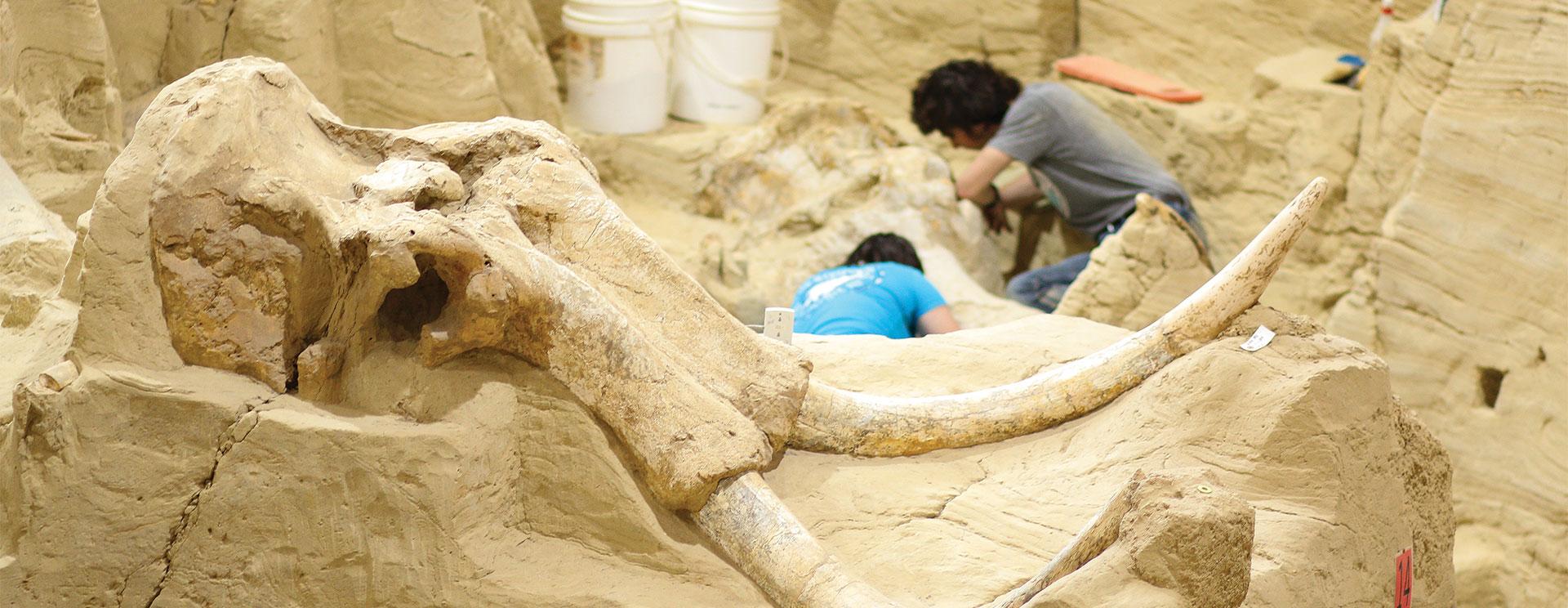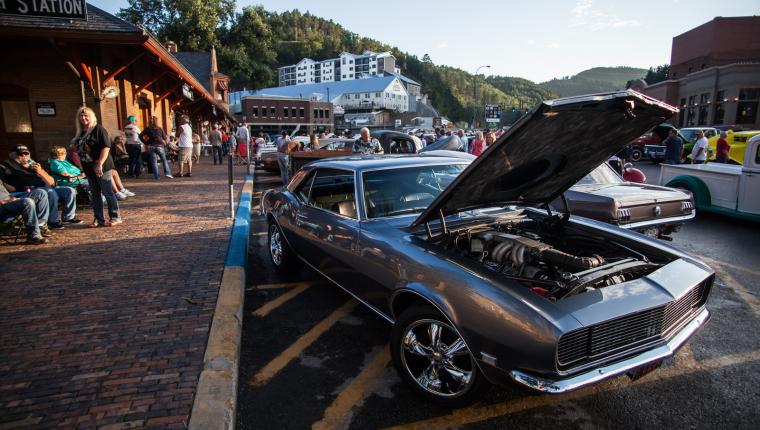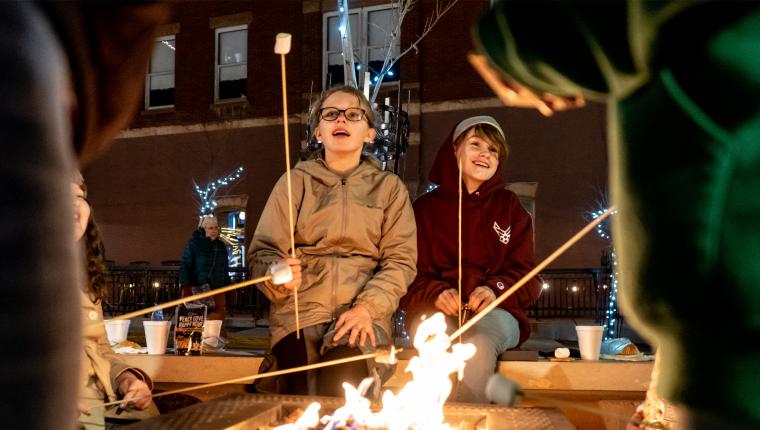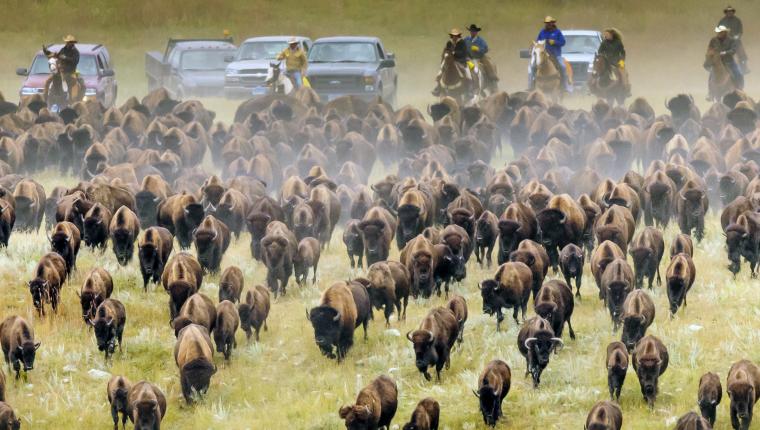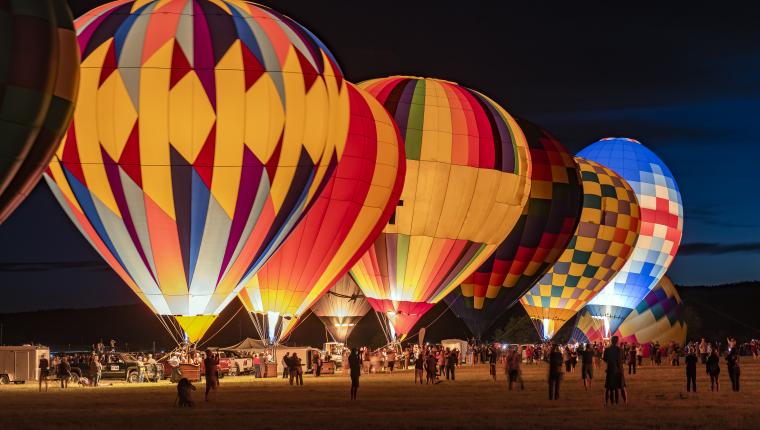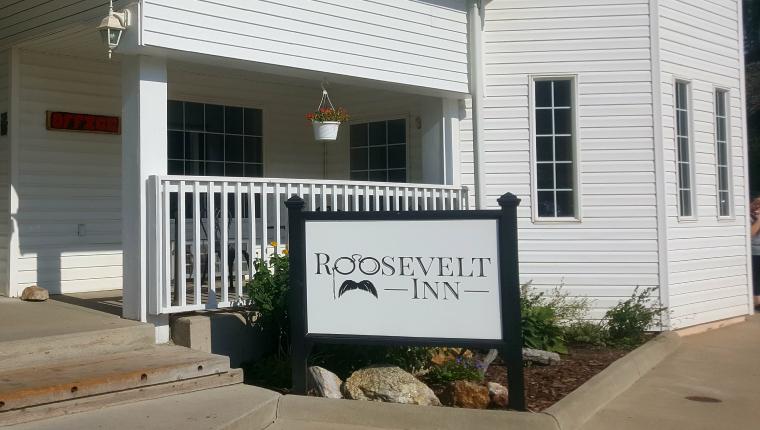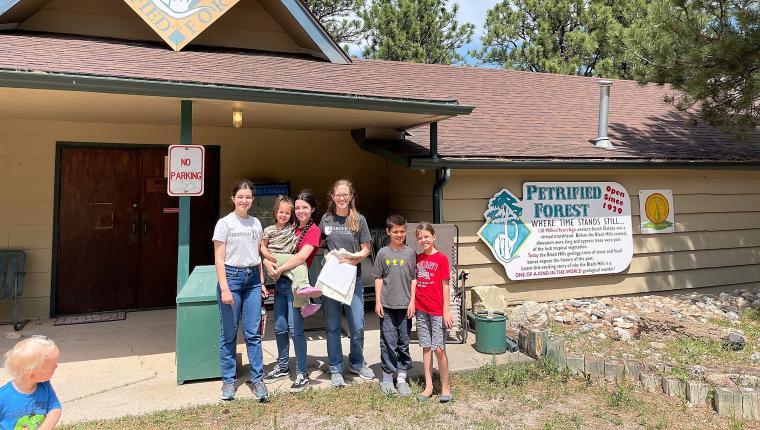For many bones and stones enthusiasts, the Black Hills evoke the intimidating form of Sue the T-rex—but what about Napoleon the Columbian Mammoth?
Once standing over 14 feet at the shoulder and weighing 10 tons, the massive forms of these Ice Age mammals are being slowly unearthed and studied at The Mammoth Site in Hot Springs, South Dakota. Starting from a happy mistake in 1974, this active paleontological dig site is now the world's largest mammoth research facility, with over 58 Columbian Mammoths and three woolly Mammoths having been unearthed since the Site's discovery.

At this world-class dig site, you can spark your inner kid and your excitement for digging up fossils or watch your little ones become enthralled with learning. The active dig site with articulated Columbian mammoth skeletons, live excavations, youth dig programs, interactive exhibits, and more are all sure to fascinate while allowing you to "keep a tusk length apart" on your Black Hills vacation.
History of the Site
In June 1974, heavy equipment operator George Hanson was preparing the plot for a housing development when the blade of his bulldozer struck ivory. Noticing its stark white color in the sunlight, he took a closer look, recognizing a tusk—seven feet long, and sliced in half along with other bones that laid inconspicuously in the soil.

Much to his luck, Hanson's son, Dan, had taken classes in geology and archaeology and recognized the bones as mammoth. Dan contacted his former professor, Dr. Larry Agenbroad, who diverted his team from a dig site in southeastern Arizona to quickly investigate the bones found in Hot Springs. At first look, Agenbroad confirmed there were four to six mammoths hidden at the Site, and he knew there had to be more.
The team spent 10 days preserving, salvaging and stabilizing the fragments found before returning the next year to discover a critical mammoth skull, cementing the Site as significant. For the next few years, the area was excavated and reburied each year to keep the fossils' integrity. This process inevitably slowed down progress and discoveries, until digging was halted to erect a building around the Site in 1980.

Each dig yielded more and more fossils with no signs of slowing down. Eventually, it became clear that the area was once a sinkhole, lined with red Spearfish shale around its edges. In its prime during the Pleistocene epoch, it was likely full of enticing water and vegetation that prompted fauna to enter and become stuck in the pit. The bright red shale that surrounded it would have been like grease, making it near impossible to escape. Thus, the sinkhole trapped mammoths, Yesterday's camel, giant short-faced bears and many smaller mammals.

Now, with over 60 Mammoths and over 80 different species discovered, The Mammoth Site has become one of the top research facilities in its field for mammoth fossils and Ice Age life. The facility continues to play a vital part in understanding the Ice Age, mammoths and our world 2 million years ago—all from a lucky accident with a bulldozer!
Enter the Bonebed
Before you make your way to the Bonebed, be sure to stop into one of the two theaters to learn about the Site and its history and immerse yourself back in time to the Pleistocene epoch, when megafauna and our early human ancestors roamed the earth.
Afterward, take the self-guided tour with The Mammoth Site app available for download, or pick up a booklet from the staff. Both have photos and detailed descriptions of the sinkhole and the numbered flags scattered about the Site. These handy tools can be great to point your eyes in the right direction and explain just what you're looking at.

After all, the sinkhole is quite large, spanning 165 feet across, and it can be difficult for the untrained eye to make out the shapes hidden in the pit. When I peered over the edge of red Spearfish shale and into the sinkhole, I wasn't sure what to be on the lookout for. However, slowly the shapes started to become distinguishable in the sands and silts of the pit, and I began to spot pelvises, tusks, skulls, femurs, tibias, fibulas, molars, spines and more.
It was a rush to suddenly see the Site filled with so many fossils, and I felt drawn to the self-tour app to learn about everything I was looking at. If you were a dinosaur kid in your younger years, the sight is sure to bring out a giddy type of joy.

Undeniably, my most favorite stop along the way was to see the two mammoth skulls (nicknamed Beauty and Beast) with their tusks still intact, proudly pointing to the sky. It's a rare sight, as the tour explains—like our teeth, there is nothing to keep the tusks connected with the skulls after the body decomposes. The most common piece to spot in the pit is tusks, all disconnected from their skulls and suspended in clay and silt among femurs, molars, and pelvises that have all been disconnected from the rest of their counterparts.

Climbing up to the highest point currently in the sinkhole, you'll not only be able to see the most complete mammoth skull found to date, but you'll also be able to look directly over the skeleton named Napoleon. Napoleon is currently the most complete Columbian mammoth skeleton found so far, and the oldest mammoth in the pit at an estimated 47 years old. When you look into the pit, you can spot him lying on his side with his spine, ribs, and femurs on display, once carrying the thousands of pounds of his massive body throughout the Black Hills.

Across the sinkhole, you can see just how giant the Columbian mammoths were, especially compared to the smaller woolly mammoth. Standing up against each of the cutouts, as well as the replica articulated skeleton of "Sinbad," many visitors are thankful they no longer roam the plains of North America.

Further along the tour at stop three, as you look along the walls of the pit, you'll be able to see noticeable lines of sediment that settled and hardened over thousands of years. Where the green arrows point, you'll notice swirls and divots where the sediment was disturbed—those are likely mammoth footprints! Based on the size of the depressions, research indicates these were likely made by mammoths wading through the sinkhole when the water was low enough for them to reach the bottom of the pond and walk.

It's hard to say just how many individual bones and fragments you're looking at when you make your way around the sinkhole. It's almost difficult to fathom how much has already been excavated. Thus far, approximately 25 feet of the sinkhole has been excavated with more to come. While the dense clay of the Site makes deep scans impossible, core samples taken in 1976 indicated that there were at least 67 feet of the pit that contained fossils. This means that researchers will be unearthing fossils and discoveries of the Ice Age world in Hot Springs for decades to come.

Still in its original place, or in situ, is the original tusk that started it all at flag ten, along with the nearly articulated skeleton of "Murray" sitting close by. Almost all of Murray is intact. This mammoth's ribs, scapula, femurs and his pelvis all sit nearly undisturbed in the dirt, but a crucial part is missing—the skull! This missing piece of the skeleton prompted the researchers to name him after the famous French aristocrat Marie Antionette, who famously lost her head in less than favorable circumstances. Morbid, but certainly funny!
Talk with the Experts
As you walk around the pit in the summer months, you'll be able to interact with interns, staff researchers, and Ice Age Explorer participants and encounter their bright sense of humor firsthand. Better yet, you can watch them carefully work to excavate and inspect the fossils in the pit, brushing away the tiniest bit of clay and examining their work with trained eyes.

Due to the water that once filled the sinkhole, the fossils have not been petrified as most dinosaur bones have, making them as delicate as the shale and clay in the pit. Researchers have to be diligent to make sure they do not damage any fragments or pieces that they uncover as they work. To help keep the fossils intact as they excavate and take them to the lab, they are soaked with a plastic preservative that artificially petrifies them.
In addition to witnessing the researchers live in action in the pit, you can also interact with them and ask them about the work they are currently doing. Staff throughout the building are friendly and knowledgeable, and the individuals working in the Bonebed ready and happy to answer your questions if they have a free moment.

Worried at first that I was bothering two researchers to stop and talk with them, they quickly assuaged my fears. As they explained, there are many perks to the job—a major one being the climate-controlled dig site—and that includes the ability to interact with visitors and renew their passion for their work daily.

While other digs will typically put them out in craggy deserts and wide-open plains with little to no company, The Mammoth Site allows them to educate the public about their field and talk through the process of excavation, inspection and understanding their finds. Additionally, while mammoths may not always be their specialty, their daily interactions with visitors allow them to gain a reinvigorated love for their work at the Site and spark interest in paleontology, geology and learning in younger generations that visit.
To the Lab
After I made it around the sinkhole—making sure to stop and compare my height to all the bears, camels, elephants and mammoths on the far wall before I left—I took the elevator in the exhibit hall and descended further down into the building to the preparation lab.

Here, you can watch as fossils are carefully cleaned, preserved and studied to help piece together a greater understanding of the sinkhole and the world as it was thousands of years ago.
Researchers not only work on the fossils and fragments discovered just a floor above them at the Bonebed, but also on pygmy mammoths from the Channel Islands. As many of the staff within The Mammoth Site are, of course, experts on mammoths and mammoth remains, many specimens and fossils from around the world are brought into their lab to study.

But that's not all—since much smaller flora and fauna are often discovered in the sinkhole, the lab also contains a well-equipped microfauna lab to study the skeletons of lizards, frogs, salamanders, snakes and more that are found during the screen washing process of excavation.
Ancient Bison, Pygmy Mammoths and More
Taking the elevator back upstairs will bring you to the exhibits housed in the building that help build a clear picture of Ice Age life for our ancestors and the natural world. I was completely enthralled with the exhibits. From the explanation of the research that's being conducted with pygmy mammoths, the breakdown of South Dakota's only known Clovis mammoth butchery site in Pine Ridge, to the massive model of the Columbian mammoth in the center of the room, it was all fascinating to take in.

If you're curious about the research that the Site lends a helping hand in, there are exhibits on the excavations at Snake River (in MN), Persistence Cave at Wind Cave National Park and the Channel Islands and how that work impacts our knowledge of the ancient world.
If you're curious to see how much you've taken in after touring all the exhibits, you can challenge your knowledge of Mammoths and The Mammoth Site with the Scarab Hunt app. Quizzes for all age groups are available to take on your own or with your whole family.
You Can Dig Big Too
The fun doesn't have to end just yet. After taking the self-guided tour of the sinkhole, your family is ready to join in on one of the paleontology programs. Held seven days a week from June to August, the Jr. Paleontology Program is a fantastic way to let your little fossil enthusiasts try their hands at a simulated excavation.
![[node:title]](/sites/default/files/styles/bhb40_1_column/public/photos/blog/2020/08/10225/20200812130051.jpg?itok=2sm2QKcx)
This amazing program teaches participants excavation techniques, including how to use a paleontologist's tools and how to identify replica mammoth and giant short-faced bear fossils. Afterward, they'll take home a fossil identification booklet and a certificate of completion to frame and show off to the whole family.
For participants 10 and over, the Advanced Paleontology Program teaches proper excavation techniques and bone identification skills, with in-depth detail on how the fossils are preserved and studied at dig sites.
The whole family can join in, take photos and take part in memories that will last for years to come. Each program is guided by the ever-friendly and accommodating staff, who are sure to make these programs a highlighted part of your Black Hills vacation.

Snacks, Sluicing and Souvenirs
If you get hungry between touring, filling your brain with Ice Age knowledge and participating in a simulated excavation, be sure to stop for a snack at the Site's new Bonebed Bistro. Enjoy a hot dog, pizza, pretzel or ice cream as you take your journey through time.

If you leave the sinkhole and have the itch to discover gems and fossils of your own, you can also purchase a sediment bag at the Bistro and sift through it with the sluice outside. Great for all ages, there's no thrill quite like discovering a beautiful gem or fossil in your screen to take home.

For bigger souvenirs, including replica castings of fossils found at the Site, take a walk through The Mammoth Site gift shop. You can take home a mammoth of your own to commemorate the trip, or purchase a book for your family to help them explore the world of mammoths, dinosaurs and the joy of learning. Even I wasn't immune to the draw—I left with a t-shirt under my arm and a head quite full of new-found knowledge about mammoths and the world of Ice Age research.
Make your next adventure one for the history books as well! Find out more about all the ways you can dig big in the Black Hills by visiting The Mammoth Site website.
